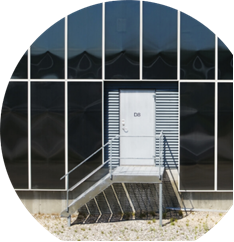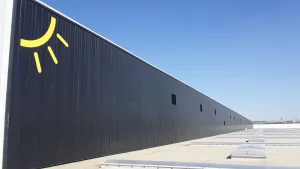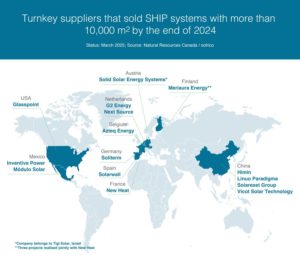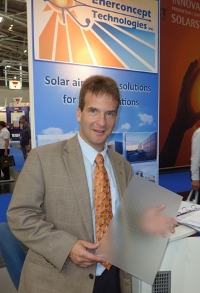“Exclusion of uncovered collectors from German funding schemes is no longer appropriate”
December 7, 2023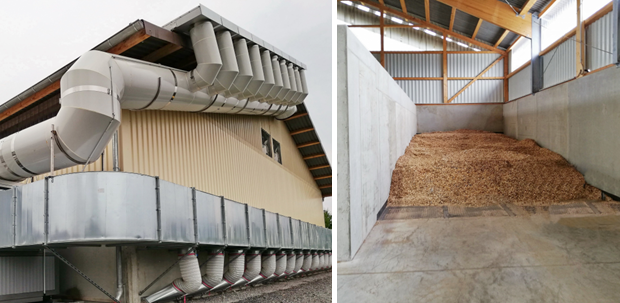
Demand for solar air heating for agricultural drying as well as heating warehouses, factories and sports halls is growing in Germany. The main suppliers of solar air collectors in Central Europe: Grammer, Cona, SolarVenti, Etapart and kWhplus all confirm this trend. However, the funding agencies in Germany make a big difference depending on whether the air collectors have a transparent cover or not. Solar air heating from collectors with covers is, for example, included in the scheme Federal Funding for Efficient Buildings (BEG) in Germany whereas perforated façade systems without glass covers are explicitly excluded. A fact that surprises representatives of both manufacturers and research institutions. The photos show a 700 m2 glass-covered, solar drying system for woodchips at the Ravesta energie biomass farm in Eastern Germany. Photos: Grammer Solar/ Ravesta energie
“Agricultural drying is a very important sales market for us. We regularly receive enquiries from biomass farms for drying systems,” confirms Rudolf Ettl, Head of Solar Air Technology at Grammer Solar in Germany. “Commercial systems now account for half of our sales, and the trend is rising.” This is also due to the good funding. Agricultural drying systems with glazed air collectors are eligible for funding from the Federal Programme for Energy and Resource Efficiency in the Economy (EEW).
Grammer Solar and the Austrian air collector manufacturer Cona Solar each submit several applications a year to EEW Module 2, which are generally approved after some delay. This was also the case for Ravesta’s system shown in the photo above. The investor Matthias Schaller confirmed that the wood chip drying plant has been operated solely with solar energy since 2022 without the use of any conventional energy sources. The solar-dried wood chips are mainly used to generate heat for a local heating network.
Solar air heating facade at a warehouse in Denmark Photo: SolarVenti
Solar air heated warehouse saves 65 % of heat costs
The Danish air collector manufacturer SolarVenti, with its German subsidiary, has so far made most of its sales in the residential sector. Here, particularly holiday homes, cellars, rooms in private homes, and garages, have been the main area of application for the collector, which has a polycarbonate cover. A special feature is the absorber fleece integrated into the collector, which filters the air drawn in and thus provides pollen-free ventilation.
“We are now aiming for more business in commercial buildings because we see a huge potential here for our technology”, said Michael Jungsvig, CEO of SolarVenti. The company has operated and monitored its first pilot project at a solar-heated warehouse in Denmark for three years and now wants to launch this system on the German market. The customer, the Danish company Dit Pulterkammer, has reduced its annual heating costs by 65 % and did not need any additional heating in the first year until December. Two effects contributed to this. Firstly, the warehouse temperature was reduced by 3 to 5 °C. Secondly, the 90 m2 air collector system in the façade of the warehouse ensured that the indoor air was significantly dehumidified.
“As our collectors raise the air temperature up to 40 Kelvin above the outside temperature, the air becomes very dry and we can gradually remove the humidity, also from the floor, walls and ceiling of the warehouse and the people’s stored belongings,” explained Jungsvig. Therefore, it is possible to reduce the ventilation for up to two months in winter when there is not enough sunshine without the air quality and temperature decreasing too much. According to SolarVenti, these results are transferable to warehouses for furniture and assembly accessories, but not to warehouses for foodstuffs. In Germany, SolarVenti can currently rely on funding from the BEG, for which companies, public authorities and non-profit organizations such as sport clubs can submit applications for air heating systems as long as the collector is covered.
Uncovered air collector explicitly excluded from programme for energy efficient buildings
The situation is different at kWhplus, a German developer of solar air heating systems founded in 2022. In addition to logistics facilities, production halls and hangers in the aviation sector, kWhplus now also wants to offer solar air heating systems for sports halls. The company buys the uncovered air collectors, which consist of perforated trapezoidal metal plates, from the Canadian company Trigo Energies. This collector type is explicitly excluded from funding due to a single sentence in the BEG funding guidelines, which came into force in November 2020: “Solar energy systems using collectors without a transparent cover on the front (e.g. swimming pool absorbers) are not eligible for funding.”
“It is distorting competition that the good yields we achieve with façade air heating systems are not taken into account in the BEG subsidy,” emphasized Michael Pulvers and Torsten Heilmann, Co-founders and Managing Directors of kWhplus. In North America, Trigo Energies’ systems have been monitored in recent years to prove their efficiency and kWhplus has enough measurement data to prove that this type of solar use is one of the most efficient solutions, confirmed the management.
Stefan Mehnert, head of the test lab Solar Thermal Systems at the Fraunhofer ISE, has held talks with the responsible Ministry of Economic Affairs and the programme administrator BAFA several times in 2022 to point out that, in his view, this blanket statement to exclude all collectors without a transparent cover from the subsidy is no longer appropriate. “Unfortunately, we were unsuccessful and this is now affecting façade air collectors in particular,” reported Mehnert.
The Fraunhofer ISE has tested several unglazed air collector systems in the past years according to the Solar Keymark scheme and has issued test certificates (see following table). In this respect, the unglazed air collectors definitely meet the funding conditions, according to which collectors must have a Solar Keymark certificate.
However, no annual yield can be determined for open air collector systems, as is possible for closed air collector systems. “With open collectors we can only determine instantaneous performance values, but no efficiency curve can be calculated from these,” explained Mehnert. However, the efficiency curve is a prerequisite for calculating the annual yield. For liquid heating collectors, a minimum yield of 525 kWh/m²a is, beside the Solar Keymark, a prerequisite for funding in Germany. Air heating collectors were excluded from this minimum yield requirement in the past.
“There are a large number of air-heated buildings in Germany whose heating energy requirements could be significantly reduced by preheating the supply air using solar façade systems. An efficient heating transition should not ignore this important technology,” summarized Mehnert.
| Manufacturer | Collector type | Collector module | Cross area | Efficiency Eta0* |
Yield in Würzburg at 25 °C | Specific yield in Würzburg at 25 °C |
| Cona, Austria | with glass cover | CCS+ | 2.05 m2 | 0.772 | 1,027 kWh/m2 | 501 kWh/m2 |
| Grammer Solar, Germany | with glass cover | GLK-M, GLK-F | 2.51 m2 | 0.794 | 1,459 kWh/m2 | 581 kWh/m2 |
| SolarVenti, Denmark | with polycarbonate cover | SV14NS | 1.39 m2 | 0.639 | n/a | |
| Trigo Energies, Canada | with polycarbonate cover | Calento SLG | 2.6 m2 | 0.441 | 602 kWh/m2** | 232 kWh/m2 |
| Trigo Energies, Canada | Uncovered | Calento SL | 2.56 m2 | 0.895 | n/a | n/a |
Key figures from Solar Keymark certificates for glazed and unglazed air collectors. Certificates from open air collector systems do not include an annual solar yield. Source: https://solarkeymark.eu/database/
* The standard includes two different methods for determining Eta0 – depending on whether the collector is operated in closed-loop mode (Grammer, Cona, Trigo Energies with Calento SLG) or in open-to-ambient mode (SolarVenti, Trigo Energies with Calento SL) .
** The lower yield of the Calento SL is explained by the fact that the collector is optimized for very cold winter days in Canada. The cover has only 66 % light transmittance, but a very good thermal insulation value of 1.1 W/m2k.
Websites of organizations mentioned in this news article:
Grammer Solar: https://grammer-solar.com/de/
Trigo Energies: https://trigoenergies.com/en/
kWhplus: https://kwhplus.de/solarluftkollektoren/
Etapart: https://www.etapart.com/de/
Cona Solar: https://www.conasolar.com/en/
SolarVenti: https://solarventi.dk/
Ravesta energie: https://www.ravesta.de/#anfang
Federal Funding for Efficient Buildings (BEG): https://www.bafa.de/DE/Energie/Effiziente_Gebaeude/effiziente_gebaeude_node.html
Federal Programme for Energy and Resource Efficiency in the Economy (EEW): https://www.energiewechsel.de/KAENEF/Redaktion/DE/Dossier/eew-energie-und-ressourceneffizienz-in-der-wirtschaft.html
